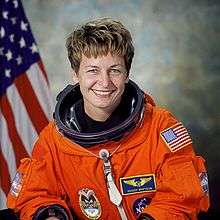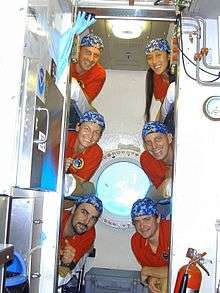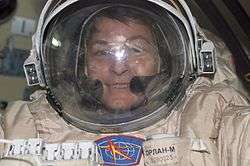Peggy Whitson
| Peggy Annette Whitson | |
|---|---|
 | |
| NASA Astronaut | |
| Nationality | American |
| Status | Active |
| Born |
February 9, 1960 Mount Ayr, Iowa, U.S. |
Other occupation | Biochemist |
|
Iowa Wesleyan College Rice University | |
Time in space | Currently in space |
| Selection | 1996 NASA Group |
Total EVAs | 6 |
Total EVA time | 39 hours, 46 minutes |
| Missions | STS-111, Expedition 5, STS-113, Soyuz TMA-11 (Expedition 16), Soyuz MS-03 (Expedition 50/Expedition 51) |
Mission insignia |
|
Peggy Annette Whitson (born February 9, 1960) is an American biochemistry researcher, NASA astronaut,[1] and former NASA Chief Astronaut. Her first space mission was in 2002, with an extended stay aboard the International Space Station as a member of Expedition 5. Her second mission launched October 10, 2007, as the first female commander of the ISS with Expedition 16.[2][3] With her two long-duration stays aboard the ISS, Whitson is NASA's most experienced female astronaut, with just over 376 days in space.[4] This also places her twenty-ninth among all space flyers. She is now in space as part of the crew of Expedition 50.
The flight of Space Shuttle mission STS-120, commanded by astronaut Pam Melroy, was the first time that two female mission commanders have been in orbit at the same time.[5][6][7]
On December 18, 2007, during the fourth spacewalk of Expedition 16 to inspect the S4 starboard Solar Alpha Rotary Joint (SARJ), the ground team in Mission Control informed Whitson that she had become the female astronaut with the most cumulative EVA time in NASA history, as well as the most EVAs, with her fifth EVA. Three hours and 37 minutes into the spacewalk, Whitson surpassed NASA astronaut Sunita Williams with a total time at that point of 29 hours and 18 minutes.[8][9] At the completion of Whitson's fifth EVA, the 100th in support of ISS assembly and maintenance, Whitson's cumulative EVA time became 32 hours, and 36 minutes, which placed her in 20th place for total EVA time.[9] Her sixth spacewalk, also during Expedition 16, brought her cumulative EVA time to 39 hours, 46 minutes, which ranked her 23rd for total EVA time as of November 2009.
Background
Whitson was born in Mount Ayr, Iowa, and grew up on a farm outside the nearby town of Beaconsfield, Iowa.[1][10] Whitson graduated from Mount Ayr Community High School in 1978 and received a bachelor of science degree in biology and chemistry from Iowa Wesleyan College in 1981. She then went on to earn her doctorate degree in biochemistry from Rice University in 1985, and following completion of her graduate work, continued at Rice as a Robert A Welch Post-doctoral Fellow until October 1986. She is married to Clarence F. Sams, Ph.D.[1]
Research career
Following her fellowship at Rice, she began working at Johnson Space Center in Houston, Texas, as a National Research Council Resident Research Associate. From April 1988 until September 1989, Whitson served as the Supervisor for the Biochemistry Research Group at KRUG International, a medical sciences contractor at NASA-JSC.[1]
From 1991 through 1997, Whitson was invited to be an Adjunct Assistant Professor in the Department of Internal Medicine, and Department of Human Biological Chemistry and Genetics at the University of Texas Medical Branch in Galveston, Texas. In 1997, Whitson began a position as Adjunct Assistant Professor at Rice University in the Maybee Laboratory for Biochemical and Genetic Engineering.[1]
From 1992 to 1995, she served as project scientist for the Shuttle-Mir Program and, until her selection as an astronaut candidate in 1996, as Deputy Division Chief for the Medical Sciences division at the Johnson Space Center.[1]
NASA career

From 1989 to 1993, Whitson worked as a Research Biochemist in the Biomedical Operations and Research Branch at NASA-JSC. From 1991–1993, she served as Technical Monitor of the Biochemistry Research Laboratories in the Biomedical Operations and Research Branch. From 1991 through 1992, she was the Payload Element Developer for Bone Cell Research Experiment (E10) aboard SL-J (STS-47), and was a member of the US-USSR Joint Working Group in Space Medicine and Biology. In 1992, she was named the Project Scientist of the Shuttle-Mir Program (STS-60, STS-63, STS-71, Mir 18, Mir 19), and served in this capacity until the conclusion of the Phase 1A Program in 1995. From 1993 through 1996, Whitson held the additional responsibilities of the Deputy Division Chief of the Medical Sciences Division at NASA-JSC. From 1995–1996, she served as Co-Chair of the U.S.-Russian Mission Science Working Group.
In April 1996, Whitson was selected as an astronaut candidate and started training in August 1996. Upon completing the two years of training and evaluation, she was assigned technical duties in the Astronaut Office Operations Planning Branch, and served as the lead for the Crew Test Support Team in Russia from 1998 to 1999. In June 2003, Whitson served as the commander of the NEEMO 5 mission aboard the Aquarius underwater laboratory, living and working underwater for fourteen days.[11] From November 2003 to March 2005, she served as Deputy Chief of the Astronaut Office. From March 2005 to November 2005, she served as Chief of the Station Operations Branch, Astronaut Office. Whitson trained as the backup ISS Commander for Expedition 14 from November 2005 through September 2006, and as the ISS Commander for Expedition 16, launched October 2007, on the Soyuz TMA-11. During Expedition 16 she surpassed Sunita Williams for woman with the most spacewalks.[1]
Whitson served as Chief of the Astronaut Office until July 2012 and, as such, was responsible for mission preparation activities of International Space Station crews and their support personnel.
Spaceflight experience

Expedition 5
The Expedition 5 crew launched on June 5, 2002, aboard STS-111 and docked with the International Space Station on June 7, 2002. During her six-month stay aboard the Space Station, Whitson installed the Mobile Base System, the S1 truss segment, and the P1 truss segment using the space station remote manipulator system; performed a 4-hour and 25 minute spacewalk in a Russian Orlan space suit to install micrometeoroid shielding on the Zvezda Service Module; and activated and checked out the Microgravity Sciences Glovebox, a facility class payload rack.
Whitson was named the first NASA Science Officer during her stay, and she conducted 21 investigations in human life sciences and microgravity sciences, as well as commercial payloads.[12] The Expedition 5 crew returned to Earth aboard STS-113 on December 7, 2002. Completing her first flight, Whitson logged 184 days, 22 hours and 14 minutes in space.
Expedition 16
Her second mission, Expedition 16, launched October 10, 2007, on Soyuz TMA-11.[13][14][15] Along with her Expedition 16 crew member Yuri Malenchenko and spaceflight participant Yi So-yeon, she returned to Earth in Soyuz TMA-11 on April 19, 2008. The re-entry was remarkable for the failure of the Soyuz propulsion module to separate properly, and the subsequent "ballistic reentry" which subjected the crew to forces about eight times that of gravity.[16] She spent 191 days, 19 hrs and 8 mins in space on this mission.[17]
Expedition 50/51
Peggy Whitson arrived at the International Space Station on Novermber 19, 2016[18] on Expedition 50/51, which was launched on November 17, 2016 from the Baikonur cosmodrome in Kazakhstan.[19] She is intended to be the commander of Expedition 51.[20][21] With the launch of Expedition 50/51 with her on it, Whitson, at age 56, became the oldest woman to fly into space.[22][23] By the end of the scheduled mission she would have spent more time in space than any other US Astronaut, surpassing the previous record of 534 days set by Jeff Williams.[24]
Awards and honors
|
| ||
References
![]() This article incorporates public domain material from websites or documents of the National Aeronautics and Space Administration.
This article incorporates public domain material from websites or documents of the National Aeronautics and Space Administration.
- 1 2 3 4 5 6 7 NASA. "Peggy A. Whitson (Ph.D.)". Biographical Data. National Aeronautics and Space Administration. Retrieved 2007-09-17.
- ↑ Tariq Malik (2007). "Space Station Astronauts Prepare for Crew Swap". Space.com. Retrieved October 9, 2007.
- ↑ Tariq Malik (October 4, 2007). "Astronauts Ponder State of Space Exploration". Fox News. Retrieved October 9, 2007.
- ↑ Spaceflight Now | Breaking News | Whitson describes rough Soyuz entry and landing
- ↑ NASA (2007). "Female Space Commanders Available for Interviews". NASA. Retrieved October 9, 2007.
- ↑ Tariq Malik (2007). "Female commanders set for landmark mission". MSNBC. Retrieved October 9, 2007.
- ↑ Internet Broadcasting Systems, Inc. (2007). "History In Space: 2 Women Commanders". Local6.com Internet Broadcasting Systems, Inc. Retrieved October 9, 2007.
- ↑ CollectSpace (2007). "Astronauts make 100th station spacewalk". CollectSpace. Retrieved December 18, 2007.
- 1 2 NASA (2007). "Spacewalkers Find No Solar Wing Smoking Gun". NASA. Retrieved December 18, 2007.
- ↑ Mansur Mirovalev (2007). "Russian Rocket Heads to Space Station". Associated Press / MSNBC. Retrieved October 10, 2007.
- ↑ NASA (March 21, 2006). "NEEMO History". NASA. Retrieved September 23, 2011.
- ↑ Banke, Jim (September 16, 2002). "NASA Boss Names Whitson ISS 'Science Officer'". Space.com. Retrieved 2007-09-17.
- ↑ Sergi Manstov (2007). "Soyuz TMA-11 launches carrying Expedition 16". NASA Spaceflight.com. Retrieved October 10, 2007.
- ↑ Jane Ritikos (2007). "First Malaysian in space". Star Publications (Malaysia). Retrieved October 10, 2007.
- ↑ Shavkat Rakhmatullayev (October 10, 2007). "Russian rocket launches first Malaysian into space". Reuters. Retrieved October 10, 2007.
- ↑ William Harwood (2008). "Whitson describes rough Soyuz entry and landing". Spaceflight Now. Retrieved July 12, 2008.
- ↑ Soyuz Capsule Misses Landing Target
- ↑ "Welcome Aboard! New Arrivals Make Six Expedition 50 Crew Members | Space Station". blogs.nasa.gov. Retrieved 2016-11-24.
- ↑ "Biography of PEGGY A. WHITSON" (PDF). NASA. 2016. Retrieved 16 February 2016.
- ↑ "NASA, Space Station Partners Announce Crew Members for Missions in 2017". NASA. 6 August 2015. Retrieved 16 February 2016.
- ↑ "ISS Expedition 51 mission patch". collectspace.com. 5 December 2015. Retrieved 16 February 2016.
- ↑ "NASA's Peggy Whitson Becomes Oldest Woman in Space - ABC News". Abcnews.go.com. Retrieved 2016-11-19.
- ↑ Chiara Palazzo Associated Press. "Nasa veteran Peggy Whitson becomes the oldest woman in space as she blasts off for ISS". Telegraph.co.uk. Retrieved 2016-11-19.
- ↑ "Peggy Whitson: Oldest woman in space blasts off to ISS". BBC News. 2016-11-17. Retrieved 2016-12-04.
External links
| Wikimedia Commons has media related to Peggy Whitson. |
| Preceded by Fyodor Yurchikhin |
ISS Expedition Commander October 10, 2007 to April 19, 2008 |
Succeeded by Sergey Volkov |
| Preceded by Steven W. Lindsey |
Chief of the Astronaut Office 2009–2012 |
Succeeded by Robert L. Behnken |